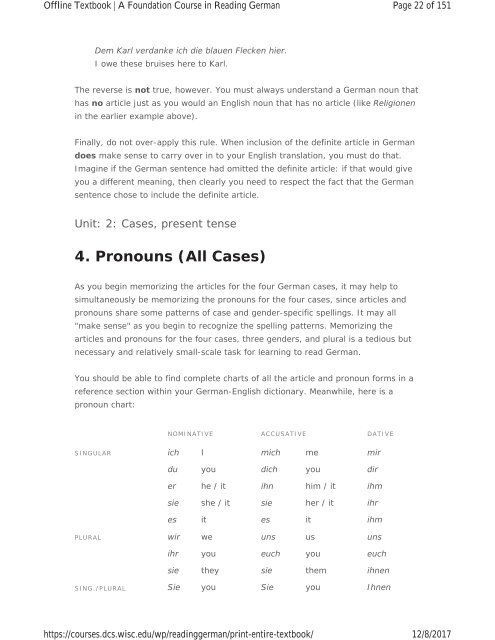A Foundation Course in Reading German, 2017a
A Foundation Course in Reading German, 2017a
A Foundation Course in Reading German, 2017a
Create successful ePaper yourself
Turn your PDF publications into a flip-book with our unique Google optimized e-Paper software.
Offl<strong>in</strong>e Textbook | A <strong>Foundation</strong> <strong>Course</strong> <strong>in</strong> Read<strong>in</strong>g <strong>German</strong><br />
https://courses.dcs.wisc.edu/wp/read<strong>in</strong>ggerman/pr<strong>in</strong>t-entire-textbook/<br />
Page 22 of 151<br />
12/8/2017<br />
Dem Karl verdanke ich die blauen Flecken hier.<br />
I owe these bruises here to Karl.<br />
The reverse is not true, however. You must always understand a <strong>German</strong> noun that<br />
has no article just as you would an English noun that has no article (like Religionen<br />
<strong>in</strong> the earlier example above).<br />
F<strong>in</strong>ally, do not over-apply this rule. When <strong>in</strong>clusion of the def<strong>in</strong>ite article <strong>in</strong> <strong>German</strong><br />
does make sense to carry over <strong>in</strong> to your English translation, you must do that.<br />
Imag<strong>in</strong>e if the <strong>German</strong> sentence had omitted the def<strong>in</strong>ite article: if that would give<br />
you a different mean<strong>in</strong>g, then clearly you need to respect the fact that the <strong>German</strong><br />
sentence chose to <strong>in</strong>clude the def<strong>in</strong>ite article.<br />
Unit: 2: Cases, present tense<br />
4. Pronouns (All Cases)<br />
As you beg<strong>in</strong> memoriz<strong>in</strong>g the articles for the four <strong>German</strong> cases, it may help to<br />
simultaneously be memoriz<strong>in</strong>g the pronouns for the four cases, s<strong>in</strong>ce articles and<br />
pronouns share some patterns of case and gender-specific spell<strong>in</strong>gs. It may all<br />
"make sense" as you beg<strong>in</strong> to recognize the spell<strong>in</strong>g patterns. Memoriz<strong>in</strong>g the<br />
articles and pronouns for the four cases, three genders, and plural is a tedious but<br />
necessary and relatively small-scale task for learn<strong>in</strong>g to read <strong>German</strong>.<br />
You should be able to f<strong>in</strong>d complete charts of all the article and pronoun forms <strong>in</strong> a<br />
reference section with<strong>in</strong> your <strong>German</strong>-English dictionary. Meanwhile, here is a<br />
pronoun chart:<br />
NOMINATIVE ACCUSATIVE DATIVE<br />
SINGULAR ich I mich me mir<br />
du you dich you dir<br />
er he / it ihn him / it ihm<br />
sie she / it sie her / it ihr<br />
es it es it ihm<br />
PLURAL wir we uns us uns<br />
ihr you euch you euch<br />
sie they sie them ihnen<br />
SING./PLURAL Sie you Sie you Ihnen


















